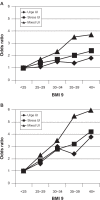Effect of weight loss on urinary incontinence in women
- PMID: 24198645
- PMCID: PMC3818946
- DOI: 10.2147/OAJU.S21091
Effect of weight loss on urinary incontinence in women
Abstract
Background: The purpose of this research was review the epidemiology of the association of obesity and urinary incontinence, and to summarize the published data on the effect of weight loss on urinary incontinence.
Methods: A literature review of the association between urinary incontinence and overweight/obesity in women was performed. Case series and clinical trials reporting the effect of surgical, behavioral, and/or pharmacological weight loss on urinary incontinence are summarized.
Results: Epidemiological studies demonstrate that obesity is a strong and independent risk factor for prevalent and incident urinary incontinence. There is a clear dose-response effect of weight on urinary incontinence, with each 5-unit increase in body mass index associated with a 20%-70% increase in risk of urinary incontinence. The maximum effect of weight on urinary incontinence has an odds ratio of 4-5. The odds of incident urinary incontinence over 5-10 years increase by approximately 30%-60% for each 5-unit increase in body mass index. There appears to be a stronger association between increasing weight and prevalent and incident stress incontinence (including mixed incontinence) than for urge incontinence. Weight loss studies indicate that both surgical and nonsurgical weight loss leads to significant improvements in prevalence, frequency, and/or symptoms of urinary incontinence.
Conclusion: Epidemiological studies document overweight and obesity as important risk factors for urinary incontinence. Weight loss by both surgical and more conservative approaches is effective in reducing urinary incontinence symptoms and should be strongly considered as a first line treatment for overweight and obese women with urinary incontinence.
Keywords: obesity; urinary incontinence; women.
Figures

References
-
- Wetle T, Scherr P, Branch LG, et al. Difficulty with holding urine among older persons in a geographically defined community: prevalence and correlates. J Am Geriatr Soc. 1995;43(4):349–355. - PubMed
-
- Wu JM, Hundley AF, Fulton RG, Myers ER. Forecasting the prevalence of pelvic floor disorders in US Women: 2010 to 2050. Obstet Gynecol. 2009;114(6):1278–1283. - PubMed
-
- Grimby A, Milsom I, Molander U, Wiklund I, Ekelund P. The influence of urinary incontinence on the quality of life of elderly women. Age Ageing. 1993;22(2):82–89. - PubMed
-
- Hunskaar S, Vinsnes A. The quality of life in women with urinary incontinence as measured by the sickness impact profile. J Am Geriatr Soc. 1991;39(4):378–382. - PubMed

